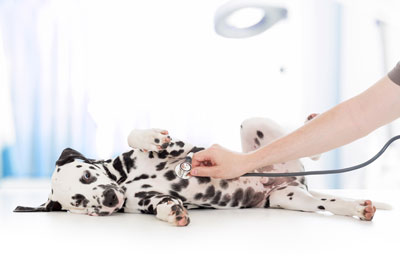Baseline Vital Signs in Dogs and How to Measure Them

If the unthinkable happens and your dog becomes very ill or injured, you may need to perform first aid. Before you can do that, though, you'll need to evaluate your dog's condition to get as much information as possible so you can decide what to do.
First, take a look at the article, "Handling and Transporting a Sick or Injured Dog." Any dog, even your own, may bite due to fear or pain, so it's important to approach her with caution and properly restrain her.
Normal Respiratory (Breathing) Rate in Dogs and How to Measure It
Dogs normally breathe between 15 and 30 times each minute. A dog that is panting may do so up to 200 times per minute.
You can measure your dog's breathing rate by watching her chest rise and fall and counting each rise. You can lay a hand on her chest to feel its rise and fall, and count each rise. You may also listen to the breaths through a stethoscope placed firmly on your dog's chest. Each of these methods will be easier for you to accomplish if you've practiced them on your dog when she is healthy.
Measure your dog's breaths for 15 seconds, then multiply your result by 4 to arrive at breaths per minute.
If your dog is not breathing, quickly check for a heartbeat (see section below). If there is none, perform CPR.
If your dog is not breathing but there is a heartbeat, perform rescue breathing.
Normal Heart Rate in Dogs and How to Measure It
If your dog is small or medium-sized, her normal heart rate should be between 70 and 140 beats per minute.
A large dog's normal heart rate is 50-120 beats per minute.
To measure your dog's heart rate, you will need a watch with a second hand or the timer on your phone.
You may take a heart rate by feeling a pulse, feeling the heart itself, or listening through a stethoscope. All of these methods will go more smoothly if you've practiced them before an emergency situation occurs.
- Finding a pulse in your dog: You may find your dog's pulse by placing two fingers inside your dog's upper thigh, right where her leg meets her body.
- Feeling your dog's heart: You may be able to feel your dog's heart by placing a hand on each side of her chest in the spot where her elbows touch her chest when her legs are flexed.
- Listening to your dog's heart: You can place a stethoscope firmly on the left side of your dog's chest where her elbow touches it when her leg is flexed to hear the heartbeat. Move the stethoscope slightly and listen again if you don't find it immediately.
Once you find your dog's heartbeat, count how many beats occur in 15 seconds, and then multiply your result by 4 to find beats per minute.
If your dog's heart is not beating, you will need to perform CPR.
Normal Canine Temperature and How to Measure It
A dog's temperature is normally between 100.2˚F and 102.8˚F.
You can measure your dog's temperature using a flexible digital thermometer.
Be sure that your dog is muzzled or is well-restrained by another person. Lying your dog on her side and having someone leaning over her from the back, holding her back legs with one hand and front legs with the other is one way to hold a dog for a temperature.
Your dog may also stand for a temperature. A helper should kneel beside the dog and place one arm around her neck from the bottom, in front of her shoulders, and the other hand should go over the dog's back in front of the hips. It is safest if the dog is muzzled for this procedure.
Place a probe cover over the thermometer and apply a liberal amount of petroleum jelly on it. Place the tip of the thermometer into the dog's rectum, which is just under the tail. Hold it there until it beeps, then read the result.
You should always call your veterinarian as soon as possible during an emergency situation with your dog. If there is another person available, one of you can call while the other checks baseline vital signs.
Normal Mucous Membrane Color in Dogs and How to Evaluate It
Your dog's gum color can tell you a lot about her condition. The gums are normally pink and moist. When you push a thumb gently into the gum, it blanches, then returns to pink in 1-2 seconds. This is called the capillary refill time (CRT).
Learn what your dog's normal gums look like. Some dogs have black pigment on their gums and are thus harder to evaluate. You may need to use the inside of the upper lip, if it is unpigmented, to evaluate mucous membrane color on those dogs instead.
Here are some gum colors and conditions that indicate an emergency is going on with your dog:
- Gum color that is yellow, brick red, pale, white, or blue
- CRT that is more than 2 seconds
Knowing what is normal for your dog and how to measure these basic vitals can mean the difference between a good and bad outcome during an emergency.
You May Also Like These Articles:
Sago Palms Are Extremely Toxic to Dogs
Black Widow Spider Bites in Dogs
What Should You Do If Your Dog's Food Is Recalled?
Foxtails: A Summertime Hazard for Dogs
Retractable Dog Leashes: Know the Risks
Disclaimer: This website is not intended to replace professional consultation, diagnosis, or treatment by a licensed veterinarian. If you require any veterinary related advice, contact your veterinarian promptly. Information at DogHealth.com is exclusively of a general reference nature. Do not disregard veterinary advice or delay treatment as a result of accessing information at this site. Just Answer is an external service not affiliated with DogHealth.com.


